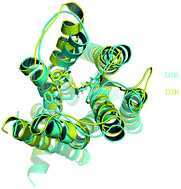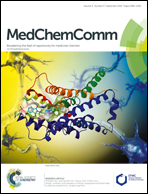Design, synthesis, and evaluation of bitopic arylpiperazine-phthalimides as selective dopamine D3 receptor agonists†
Abstract
The dopamine D3 receptor (D3R) is a proven therapeutic target for the treatment of neurological and neuropsychiatric disorders. In particular, D3R-selective ligands that can eliminate side effects associated with dopamine D2 receptor (D2R) therapeutics have been validated. However, the high homology in signaling pathways and the sequence similarity between D2R and D3R have rendered the development of D3R-selective ligands challenging. Herein, we designed and synthesized a series of piperazine-phthalimide bitopic ligands based on a fragment-based and molecular docking inspired design. Compound 9i was identified as the most selective D3R ligand among these bitopic ligands. Its selectivity was improved compared to reference compounds 1 and 2 by 9- and 2-fold, respectively, and it was 21-fold more potent than compound 2. Molecular docking demonstrated that the orientation of Leu2.64 and Phe7.39 and the packing at the junction of helices may affect the specificity for D3R over D2R. Functional evaluation revealed that D3R-selective ligand 9i displayed a subpicomolar agonist activity at D3R with a 199-fold increase in potency compared to quinpirole. These results may be useful for the fragment-based design of bitopic compounds as selective D3R ligands.



 Please wait while we load your content...
Please wait while we load your content...